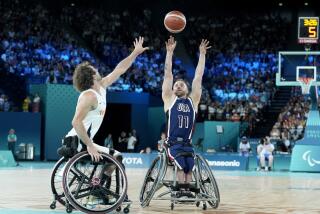Trapped in the driver’s seat
- Share via
Robert Scott doesn’t want sympathy -- only about 3 feet of space in a parking lot.
Scott, who has been paraplegic since birth, drives a car equipped with special hand controls for the brakes and accelerator. To get in, he wheels up to the door, lifts himself into the driver’s seat and then disassembles his wheelchair one piece at a time. He throws the pieces into the back seat.
“I have always been completely independent,” Scott said. “This includes driving on my own since I was 18.”
Scott is employed as a mortgage loan officer. He likes to go shopping and attend rock concerts. But it’s getting tougher.
As I have noted before, the choice parking places once reserved for those with serious mobility problems are increasingly taken up by those who have fraudulently obtained disabled placards or kept using a placard after a condition has been cured.
The placards not only reserve choice spots for the disabled, but also grant free parking at meters and unlimited parking at any legal space on the street. It’s a better deal than even Scott needs.
“I don’t need a parking spot near a door, but I do need about 3 feet of space so I can get in and out of my wheelchair,” Scott said. “Not only am I completely independent, but I keep myself in great shape.
“I can’t tell you how often it takes me 10 to 20 minutes to park, because all of the disabled parking is taken,” Scott added. “I don’t think the public understands how big of an issue this is in the disabled community.
“Every time I go to a large event like a concert or sports event, I rarely get a disabled parking spot unless I am there very early. You see, people think that I am lucky that I get such great parking, but they don’t take into consideration what I go through when it’s not available.
“I would trade anyone my parking spot for the ability to get in and out of my car at will.”
In Scott’s view, a lot of people using disabled parking places are not disabled. “Now, it seems that anyone with a medical complaint or a good relationship with their physician can get a placard. I’ve seen people put up their placard and literally run into the store.”
Scott’s comments came after I wrote a column on placard abuse a couple of months ago, which generated a large response from an outraged public.
About 2.6 million motorists in California have disabled placards and license plates, amounting to 11% of licensed drivers. Of course, many of them honestly need placards.
The spots are designated with a wheelchair symbol, but you certainly don’t need to use a wheelchair to get a placard. The federal Americans With Disabilities Act was passed in 1990, and parking guidelines were promulgated a couple years later. But as more parking spaces are put off-limits to the general public, the incentives for abuse are growing. And people see it all the time.
“My wife and I play golf at Roosevelt Golf Course in Griffith Park,” wrote Gary Robb of Los Angeles. “It is a hilly nine-hole course with no electric carts, requiring about three miles of walking. The three handicapped spaces are usually filled. We are in our late 70s and like the exercise, but we wonder how disabled players can walk the course.”
Robb asks a reasonable question, though certainly it is difficult to assess who is disabled from mere appearances.
“It is a big concern to people with ‘hidden’ disabilities that they are not taken seriously,” said Jennifer Weiser Bezoza, an attorney with Disability Rights Advocates, a nonprofit group in Berkeley. “There are people who do not use a mobility device [wheelchair, walker, cane, etc.] who could not walk across a large parking lot. On the other hand, we have wheelchair athletes who clearly can get across a parking lot.”
Bezoza is right, but how “hidden” is that disability if you’re playing nine holes of golf?
More rigorous oversight of who receives placards is needed, but last year the state Legislature loosened restrictions on who in the medical profession can authorize a placard. Now, midwives and physician assistants can order them for a patient. The Department of Motor Vehicles may also be asleep at the switch.
One 81-year-old reader of Your Wheels wrote to complain that he obtained a placard good for two years from his doctor after knee replacement surgery. After it ran out, DMV automatically sent him another one good for two years.
“Everyone I know using a handicap placard is having them automatically renewed,” he wrote.
More to Read
Sign up for Essential California
The most important California stories and recommendations in your inbox every morning.
You may occasionally receive promotional content from the Los Angeles Times.











